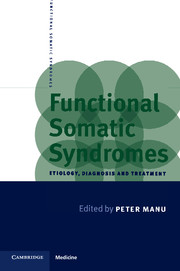Book contents
- Frontmatter
- Contents
- List of contributors
- Preface
- 1 Definition and Etiological Theories
- 2 Chronic Fatigue Syndrome
- 3 Fibromyalgia Syndrome
- 4 Irritable Bowel Syndrome
- 5 Premenstrual Syndrome
- 6 Interstitial Cystitis
- 7 Temporomandibular Disorders
- 8 Chest Pain Syndromes
- 9 Repetitive Strain Injury
- 10 Multiple Chemical Sensitivities
- 11 Psychopharmacology of Functional Somatic Syndromes
- 12 Psychotherapy of Functional Somatic Syndromes
- 13 Determination Of Disability Claimed By Patients With Functional Somatic Syndromes
- 14 Functional Somatic Syndromes: Exploring Common Denominators
- Index
5 - Premenstrual Syndrome
Published online by Cambridge University Press: 08 January 2010
- Frontmatter
- Contents
- List of contributors
- Preface
- 1 Definition and Etiological Theories
- 2 Chronic Fatigue Syndrome
- 3 Fibromyalgia Syndrome
- 4 Irritable Bowel Syndrome
- 5 Premenstrual Syndrome
- 6 Interstitial Cystitis
- 7 Temporomandibular Disorders
- 8 Chest Pain Syndromes
- 9 Repetitive Strain Injury
- 10 Multiple Chemical Sensitivities
- 11 Psychopharmacology of Functional Somatic Syndromes
- 12 Psychotherapy of Functional Somatic Syndromes
- 13 Determination Of Disability Claimed By Patients With Functional Somatic Syndromes
- 14 Functional Somatic Syndromes: Exploring Common Denominators
- Index
Summary
Premenstrual symptoms in women are a common phenomenon, and the clinician must perform a careful medical and psychological screening to evaluate the severity of the symptoms as well as to rule out comorbid psychiatric and medical disorders. Progress in defining the premenstrual syndrome (PMS) in the past two decades has allowed recent studies to begin to elucidate the etiology and treatment of premenstrual symptoms. This chapter reviews the diagnostic issues, epidemiological variables, pathogenetic hypotheses and the treatment options now available to treat PMS.
History
The term ‘premenstrual tension’ was coined by Frank 70 years ago (Frank et al., 1937), but descriptions of emotional symptoms being related to menstruation date back to antiquity (Severino & Moline, 1989). In the past two decades, progress has been made in defining premenstrual symptoms, assessing prevalence and predictors, searching for etiologies and assessing the efficacy of pharmacological and nonpharmacological treatments. Research criteria for definitions of severe premenstrual symptoms have existed in the two most recent editions of the Diagnostic and Statistical Manual of Mental Disorders, DSM-III-R (1987) and DSM-IV (American Psychiatric Association, 1994). Although some authors question the validity of disturbing premenstrual symptoms as constituting an ‘illness’ (Gurevich, 1995; Richardson, 1995), the existence of research diagnostic criteria has expanded the knowledge about the etiology and treatment of premenstrual symptoms.
PMS can be defined as emotional, behavioral and physical symptoms that occur in the luteal phase of the menstrual cycle of women, with resolution of the symptoms following the menses.
Keywords
- Type
- Chapter
- Information
- Functional Somatic SyndromesEtiology, Diagnosis and Treatment, pp. 80 - 97Publisher: Cambridge University PressPrint publication year: 1998
- 2
- Cited by

